Physical Address
304 North Cardinal St.
Dorchester Center, MA 02124
The clinical burden of severe functional tricuspid regurgitation can be substantial, with limited transcatheter options for those at prohibitive risk for surgical repair/replacement.
The tricuspid apparatus is complex and far more heterogeneous (with respect to number of leaflets and the associated subvalvular apparatus) than the mitral valve.
Percutaneous tricuspid valve edge-to-edge repair carries the most clinical experience, with larger-scale randomized trials under way.
Many additional transcatheter technologies that mimic surgical repair/replacement techniques are under varying stages of early development and clinical testing.
In the contemporary era, there has been a relative explosion of interest in the design, development, and clinical dissemination of transcatheter technologies for aortic, mitral, and pulmonic valve disease. Many of these transcatheter techniques mimic established surgical approaches that have been performed for decades. The tricuspid valve (TV), often referred to as the “forgotten valve,” has historically been understudied owing to its substantial anatomic variations and attributable disease processes and that most symptomatic tricuspid regurgitation (TR) is due to secondary or functional TV disease. Indeed, contemporary series report concomitant TV surgery in up to 60% patients undergoing surgery for primary left-sided aortic or mitral valve (MV) disease. Hence significant TV disease is usually a surrogate for advanced-stage left-sided disease. When this is unaddressed during index surgical intervention for left-sided disease, patients experience increased morbidity and mortality. With the burgeoning field of transcatheter technologies for aortic and MV disease, it is clear that those patients with concomitant and untreated TV regurgitation carry a less favorable long-term prognosis. Therefore considerable interest has now shifted to the development of transcatheter technologies that allow for the treatment of TR to be performed in conjunction with or staged with transcatheter aortic or MV intervention. This chapter reviews the TV anatomic complex and the clinical relevance of surgical approaches; it also offers an update on transcatheter technologies in practice and in development for symptomatic TR.
The classic description of the TV complex says that it consists of three leaflets (anterior, posterior, and septal), the chordae tendineae, two discrete papillary muscles, the fibrous tricuspid annulus, and the right atrial (RA) and ventricular myocardium ( Fig. 57.1 ). Successful valve function depends on the integrity and coordination of these components. However, considerable variability exists in the number of leaflets, papillary muscles, location of scallops or indentations, annular geometry, and the array of the chordae tendineae. More recent anatomic reviews debate which is the largest TV leaflet—anterior versus posterior ( Fig. 57.2 ). The septal leaflet is the smallest and arises medially directly from the tricuspid annulus above the interventricular septum. The anterior papillary muscle provides chordae to the anterior and posterior leaflets, and the medial papillary muscle provides chordae to the posterior and septal leaflets. The septal wall gives chordae to the anterior and septal leaflets (there is no formal septal papillary muscle, as with the anterior and posterior papillary muscles). In addition, there may be accessory chordal attachments to the right ventricular (RV) free wall and the moderator band.
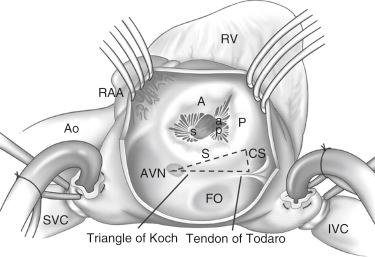
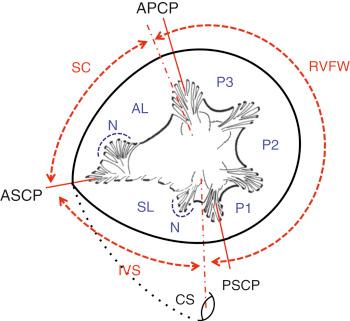
The overall length of the TV leaflets varies; however, the circumference of the anterior and posterior leaflets are of equal length. The anterior leaflet is the most mobile, whereas the septal leaflet is the least. The posterior leaflet is the shortest, with multiple scallops; anatomically it may not be clearly separated from the anterior leaflet in approximately 10% of the population. Additionally, anatomic landmarks of the leaflets vary considerably with one notable exception: the commissure between the septal and posterior leaflets is usually located near the entrance of the coronary sinus (CS) into the RA.
The tricuspid annulus has a complex three-dimensional structure, which differs from the more symmetric “saddle-shaped” mitral annulus. In an effort to better understand the shape and movement of the healthy and diseased tricuspid annulus, Fukuda et al. performed a real-time three-dimensional transthoracic echocardiographic (TTE) study. They examined 15 healthy subjects and 16 patients with functional TR (FTR); 75% had moderate to severe TR. The tricuspid annulus was mapped throughout the cardiac cycle and reconstructed on a computer workstation. Patients with FTR generally had a more planar annulus, which was dilated primarily in the anterior (along RV free wall) direction, resulting in a more circular shape as compared with the elliptical shape in healthy subjects.
Because the small septal wall leaflet is fairly fixed, there is little room for movement if the free wall of right ventricular/tricuspid annulus should dilate. Dilation of the tricuspid annulus therefore occurs primarily in its anterior aspect, which can result in significant FTR as a result of leaflet malcoaptation ( Fig. 57.3 ). Other important factors influencing the degree of TR include right ventricular preload, afterload, and right ventricular systolic function. The influence of intravascular volume status and underlying right ventricular function on TV function stems from the fact that the tricuspid annulus is very dynamic and can change markedly with loading conditions. Even during the cardiac cycle, there is an approximately 19% reduction in annular circumference (≈30% reduction in annular area) with atrial systole.
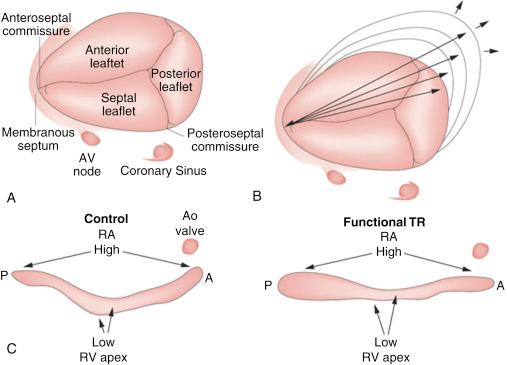
The TV leaflets are generally supported by two papillary muscles (anterior and posterior), with 20% of the population having a third (septal). The anterior is the largest, with a complex array of chordae supporting the anterior and posterior leaflets. The posterior papillary muscle can subdivide into two to three segments giving off chordae to the posterior and septal leaflets. A moderator band, if present, usually connects to the anterior papillary muscle. Finally, chordae can arise directly from the interventricular septum to the anterior and septal leaflets or the RV free wall to the anterior and posterior leaflets.
Other important anatomic structures involved with the TV complex, especially as it relates to potential transcatheter targets, are the superior and inferior venae cavae (SVC and IVC), atrioventricular node (AVN), right coronary artery (RCA), and CS. In humans, the origin of the SVC is located posterior to the RA appendage and adjacent to the interatrial septum. The origin of the IVC is formed anteriorly and superiorly by the eustachian valve (or its remnant). The tendon of Todaro serves as the posterior border of the triangle of Koch, with the anterior border being the CS. The triangle is completed more medially by the AVN (see Fig. 57.1 ). Surgeons will use these anatomic landmarks to locate the AVN when they are performing either suture- or ring-based annuloplasty or TV replacement (discussed later); these landmarks may become important for transcatheter technologies that mimic these surgical approaches.
The prototypical patient with TR often has annular dilation and right ventricular enlargement, which is often due to left heart failure from myocardial or valvular causes, right ventricular volume and pressure overload, dilation of cardiac chambers, and at times permanent atrial fibrillation. This form of regurgitation is referred to as secondary or functional in etiology (functional TR, or FTR). With progressive dilation of the ventricle and annulus, there is failure of leaflet coaptation (loss of coaptation length) and an increase in tenting height. Less common causes of TV pathology include rheumatic or congenital heart disease, endocarditis, leaflet tear/prolapse, chordal rupture, papillary muscle rupture, or myxomatous degeneration of the TV ( Table 57.1 ).
| Secondary (75%) |
| Left heart disease (left ventricle dysfunction or valve disease) resulting in pulmonary hypertension |
| Any cause of pulmonary hypertension (chronic lung disease, pulmonary thromboembolism, left-to-right shunt) |
| Interatrial or interventricular shunt resulting in left-to-right shunting |
| Any cause of RV dysfunction (myocardial disease, RV ischemia/infarction, idiopathic) |
| Permanent atrial fibrillation |
| Isolated annular dilation (idiopathic tricuspid regurgitation) |
| Primary (25%) |
| Rheumatic |
| Myxomatous—seen in up to 40% of patients with myxomatous mitral valve degeneration |
| Congenital (Ebstein anomaly, TV dysplasia, ventricular septal defect–related TV tethering) |
| Endocarditis (bacterial, marantic) |
| Endomyocardial fibrosis |
| Carcinoid |
| Traumatic (blunt chest injury, laceration) |
| Iatrogenic (pacemaker/defibrillator lead, RV biopsy) |
| Drug-induced disease (anorectic drugs, fenfluramine, phentermine, pergolide). |
| Ischemic heart disease affecting the RV with papillary muscle dysfunction or rupture. |
With isolated TR, patients may experience fatigue and decreased exercise tolerance as a result of decreased cardiac output. They may also experience the classic symptoms of “right-sided heart failure” from elevated RA pressures, such as ascites, congestive hepatopathy, peripheral edema, decreased appetite, and abdominal fullness. The assessment of intravascular volume status in a patient with severe TR can be difficult because of the pulsatile jugular venous pressure on physical examination. Atrial fibrillation is common as a result of RA enlargement.
The TV is arguably the most difficult valve to visualize and to assess quantitatively. Some of this difficulty is due to the variable anatomy of the TV complex. Until recently, there has been a deficit of clinical research focused on how to standardize qualitative and quantitative TV imaging. With renewed interest in the TV as a potential target for transcatheter techniques, there are now more guidelines and review articles attempting to standardize imaging of the TV ( Table 57.2 ). An in-depth review of the qualitative and quantitative TTE and transesophageal echocardiographic (TEE) assessment of TR are beyond the scope of this chapter. However, the following paragraphs offer a brief review the role of TTE and an overview of the TEE imaging planes needed to identify the specific TV leaflets required for transcatheter therapies.
| Publication | Number of Pages Devoted to | ||
|---|---|---|---|
| MV + AV | TV + PV | Ratio | |
| 2003—ASE Native Valve Regurgitation | 11 | 5.5 | 2:1 |
| 2008—ASE Native Valve Stenosis | 15 | 4 | 4:1 |
| 2009—ASE Prosthetic Valves | 10.5 | 5.5 | 2:1 |
| 2014—ACC/AHA Valve Disease | 36 | 6 | 6:1 |
| 2017—ASE Native Valve Regurgitation | 27 | 15 | 2:1 |
For TTE, multiple thoracic windows with slight adjustments are needed to identify all three leaflets of the TV ( Figs. 57.4–57.6 ). With this methodology, all three leaflets can be reproducibly seen on every patient. Adjunctive assessment of TV pathology requires careful assessment of IVC diameter and collapsibility, RV systolic pressure, and hepatic vein flow reversal.
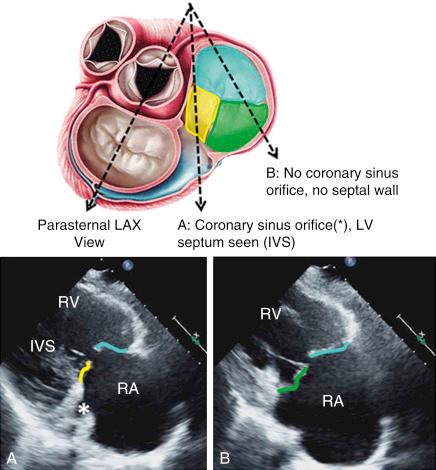
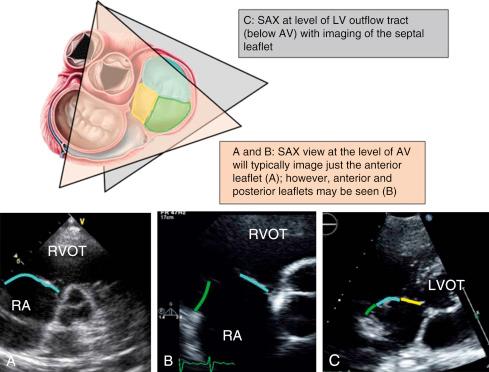
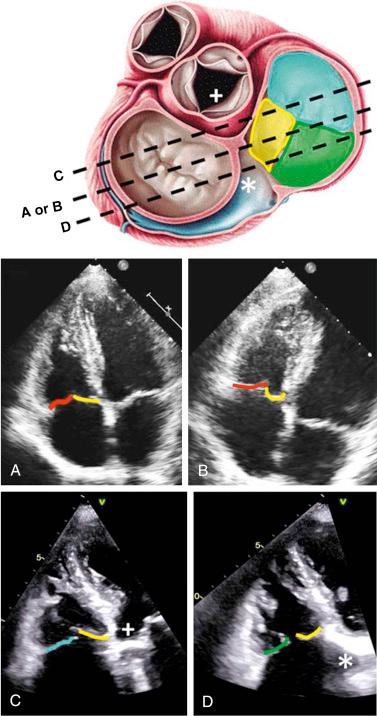
Further interrogation with TEE is usually warranted, particularly for intraprocedural guidance. None of the guidelines have offered standardized TEE views to assess the TV leaflets. Our standard approach consists of obtaining dedicated sweeps along coaptation zones in the midesophageal, commissural, and transgastric views. The midesophageal view allows one to sweep the TV as the probe is advanced and retracted ( Fig. 57.7 ). Starting in the esophagus, once the TV is encountered in the zero-degree omniplane, first the septal and anterior leaflets are usually identified; as the probe is pushed further in, the view changes to one that includes the septal and posterior leaflets ( ![]() ). Even in the midesophageal view, it can be difficult to ascertain which leaflets are being viewed. With a slight antero- and/or retroflex at the zero-degree omniplane in the midesophageal view, if the aortic valve comes in and out of view, the image will be of the anterior and septal leaflets. On the other hand, if one retroflexes and the CS comes in and out of view, the posterior and septal leaflets will be seen ( Fig. 57.8 ).
). Even in the midesophageal view, it can be difficult to ascertain which leaflets are being viewed. With a slight antero- and/or retroflex at the zero-degree omniplane in the midesophageal view, if the aortic valve comes in and out of view, the image will be of the anterior and septal leaflets. On the other hand, if one retroflexes and the CS comes in and out of view, the posterior and septal leaflets will be seen ( Fig. 57.8 ).
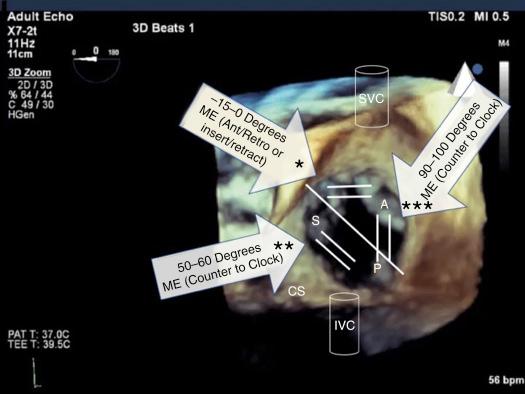
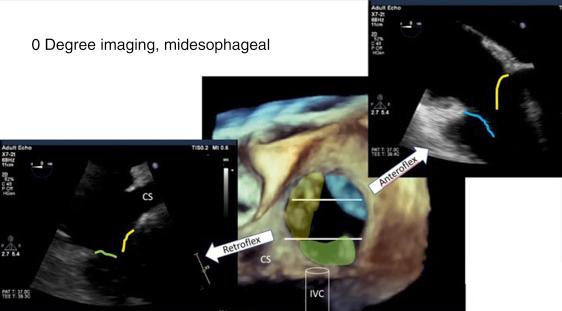
After the midesophageal sweep, a commissural view of the TV is attempted. The goal of this view is to obtain a cross section of the TV and attempt to capture the anteroseptal and anteroposterior commissure. This is generally obtained in the midesophageal position with the omniplane at 50 to 60 degrees. This view will generally aim to provide the aortic valve and the septal, anterior, and posterior leaflets all in the same image. An x-plane is then obtained from this image; starting medially to laterally, one can see the anteroseptal coaptation, anterior septoposterior coaptation, and finally the anteroposterior coaptation ( ![]() ).
).
Finally, perhaps the best imaging plane from which to visualize all three TV commissures is the transgastric short axis. This view is generally achieved by advancing the TEE probe into the stomach with substantial anteroflexion. Once the TV is in view, slight adjustments in the omniplane at zero or 180 degrees will allow one to achieve this commissural view ( Fig. 57.9 ). In the transgastric view, the omniplane can also be changed to 90 degrees and the long axis of the RV is visualized. Additional anteroflexion at this point will enable visualization of the posteroseptal coaptation plane and retroflexion will provide the anteroposterior coaptation plane ( Fig. 57.10 ).
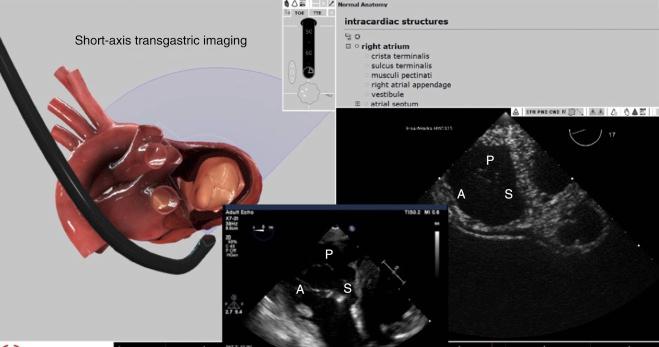
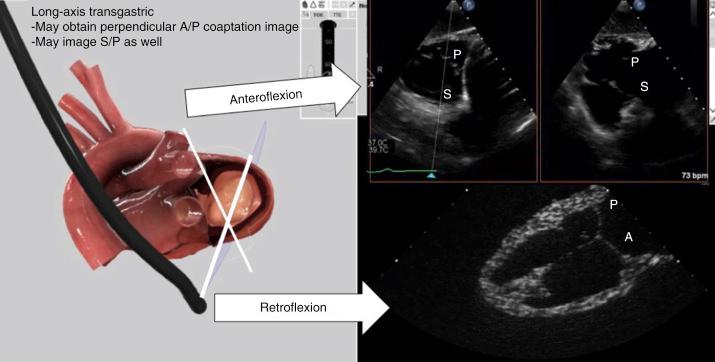
The use of three-dimensional (3D) echocardiography has become critically important as an adjunct to structural heart interventions and no longer requires mental reconstruction of multiple two-dimensional images. We generally position/orient the 3D en face view of the TV in the same orientation as the “surgeons view.” The aortic valve and the septal leaflets are positioned on the left, with the anterior leaflet at the 12- to 3-o’clock position, and the posterior leaflet positioned from the 3- to 6-o’clock position (see Fig. 57.7 ).
Future advances in echocardiographic imaging will make transcatheter TV interventions more accessible and feasible for standard clinical use. Numerous technologies are in development that will allow real-time high-resolution 3D images to be obtained from an intracardiac imaging probe that can be positioned in the RA, perhaps eliminating the need for TEE and general anesthesia.
There are a variety of technologies with varying mechanisms for reducing TR that are under preclinical and clinical evaluation. The main categories of transcatheter approaches for TV repair consist of (1) edge-to-edge repair techniques analogous to the MitraClip system (Abbott, Santa Clara, CA), (2) intravalvular coaptation devices, and (3) annuloplasty devices. In addition, caval valve implantation (CAVI) has been performed in an effort to reduce the effects of TR without necessarily impacting the TV complex itself. Finally, de novo transcatheter TV replacement has also recently been performed. Although there has been considerable interest in the development of these technologies, no one device or system has emerged as a leading approach owing to the complexity of the TV complex, its associated structures, and difficulty with durable TR reduction. Some of the global challenges for transcatheter-based devices include the following:
The tricuspid annulus is in close proximity to the RCA and damage or interaction with annuloplasty-based devices can occur.
The annular and leaflet tissue is more fragile and thinner than the MV, leading to potentially greater chances of dehiscence and tearing, particularly with annuloplasty-based devices.
Due to chordal density, tricuspid subvalvular maneuvering of catheter-based devices carries a greater risk of entanglement than it does for the subvalvular mitral apparatus.
Catheter navigation within the RA via fluoroscopy and TEE guidance is not straightforward, since the RA size, angle of the IVC to the tricuspid annulus, tricuspid annular shape, and number of tricuspid leaflets are all highly variable.
Standardized imaging of the TV and TR grading remains a challenge, although renewed interest in this topic may resolve such issues in the future.
Imaging of the TV complex with intracardiac catheters present can be suboptimal due to substantial shadowing.
Despite the challenges, the interventional community continues work to define and refine the TV technologies, their role in the treatment of TR, and the clinical outcomes from their implementation. The following text outlines the major devices in the field of transcatheter TV technologies, their current state of development, and their stage of clinical application.
A dedicated first-generation steerable guide catheter (SGC) and a clip delivery system (CDS) for the TV has been developed (tricuspid valve repair system [TVRS]) and is in use for an early feasibility trial (Evaluation of Treatment With Abbott Transcatheter Clip Repair System in Patients With Moderate or Greater Tricuspid Regurgitation [TRILUMINATE] Clinical Trial, NCT03227757 ). However, more than 300 cases of edge-to-edge repair of the TV with the traditional MitraClip System have been performed. The main differences between the TVRS and the commercial MitraClip systems are shorter working lengths of both the guide catheter and the CDS to allow ease of navigation within the RA. As widespread commercial availability for a dedicated TVRS is at least 3 to 5 years away, the remainder of this section describes only edge-to-edge repair of the TV using the standard MitraClip system.
Both European and U.S. registries have confirmed that residual TR after transcatheter MV repair is associated with increased mortality. Over the past 5 years several independent centers and one large multicenter registry have confirmed the safety and feasibility of TV edge-to-edge repair with the MitraClip system. Procedural success was not consistently defined but the one common definition appears to be placement of a single clip with at least a one-grade reduction in TR. Based on this definition, procedural success is reportedly 91% to 97% without any major complications. Surprisingly, with clip placement and with as little as a single-grade reduction in TR, registry reports indicate improvement in New York Heart Association (NYHA) grade at discharge and an improved 6-minute walk test (6MWT) at 30 days. These nonrandomized data are all that is available to the interventional community thus far with respect to edge-to-edge repair of the TV. The TRILUMINATE early feasibility study is a 25-center 75-patient global trial to evaluate the dedicated TVRS system (shorter working length of the SGC and CDS) for symptomatic moderate or severe TR. Enrollment for the early feasibility trial has completed with a pivotal (randomized) trial slated to begin in late 2019/early 2020. Additionally, there is a global registry of edge-to-edge repair of the TV with the off-label use of MtiraClip under way to describe procedural characteristics and outcomes of this approach.
Become a Clinical Tree membership for Full access and enjoy Unlimited articles
If you are a member. Log in here